Health is trendy. Wearables are too. And I believe that medical wearable devices were meant to be, and soon the perspectives of medical app development will become even more evident.
Many people are now using apps for smartwatches and wristbands that act as their personal trainers, and for some, it may seem, that wearables are booming. Indeed, the wearables industry is expected to grow. In this article, we’ll look at the best health apps for wearables.
Current state of the healthcare wearable market
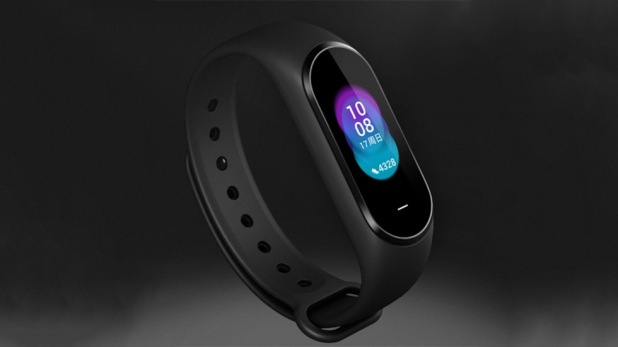
According to MarketsandMarkets by 2022 the worldwide market of medical wearables will be worth $14 billion, compared to $6 billion in 2017.
Impressive, isn’t it? Then why are wearables manufacturers facing so many problems with selling their devices? Out of dozens of brands, only a few companies like Apple and Xiaomi manage to stay profitable.
What’s the reason? The most common is that they don’t offer anything more than a smartphone does: smartphones can also count steps and calories, measure distance and track user location. Moreover, fitness wristbands and smartwatches are often uncomfortable and even ugly.
There is certainly a future for fitness wearables, just like there are ways to improve them, but we’re sure that the future of wearables is in healthcare.
Here is the current state of the wearable market and predictions for future years.
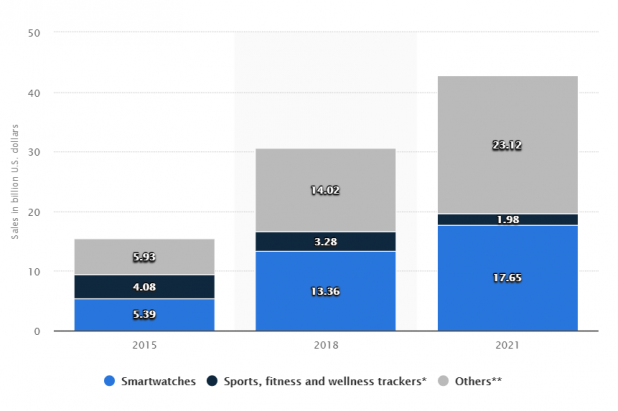
As you can see, fitness wearables like wristbands are becoming less popular, while the smartwatches market will only grow. The reason for this is that smartwatches, particularly those made by Apple, are offering something that a smartphone can’t provide. For example, the newest Apple Watch is able to measure users’ heart rate and detect falls and emergencies.
Smartwatches are acquiring healthcare features, and this trend is here to stay. But there are lots of other healthcare medical devices that will soon help people with all kinds of health issues, from high blood pressure and diabetes to recovery after chemotherapy. Let’s take a look at some.
Types of medical wearables
While wristbands and smartwatches are still the most popular, medical wearable devices offer far more. I’d say that other healthcare wearable devices have a narrower and less saturated market with great potential.

Now let’s talk about the most popular types of medical wearables in more detail.
Smart watches
Smart watches are not only fashionable accessories and fitness devices, but can also be used for healthcare.
I already mentioned Apple Watch that has healthcare features. Other smartwatch makers also plan to follow this trend: for example, Fitbit partnered with Google to share medical data with doctors via Google Cloud.
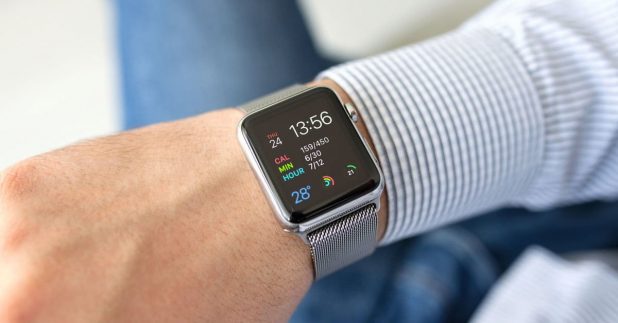
Insurance companies are also supporting this trend as they start to support digital medicine. For example, at John Honcock Insurance you can earn a discount by wearing a tracker and meeting fitness goals.
Glucose monitors
Glucose monitors are becoming more and more popular among diabetic people who can track their glucose levels 24/7.
They still need to check their glucose level using a blood test, but they only need to do so twice a day to see if the results of the glucose monitor matches the blood test result.
Taking meals and medication depends on the current glucose level, and monitoring it continuously can help to make more informed decisions on daily routines. A glucose monitor uses a small sensor placed under the skin that tests glucose levels every few minutes. If the glucose level is too high or low, the user will receive an alert.
Diagnostic chips
Tiny chips for diagnosis can help doctors find out what’s wrong with a patient. For example, an optical sensor developed by the Australian National University is able to help with diagnosing a number of diseases in real-time. The sensors detect biomarkers from metabolite gases released through human skin and breath.
Another sensor like this as shown in the picture below is a tiny sensor that looks and feels like a temporary tattoo. A side effect of many wearable devices is skin irritation, but it’s not the case here.
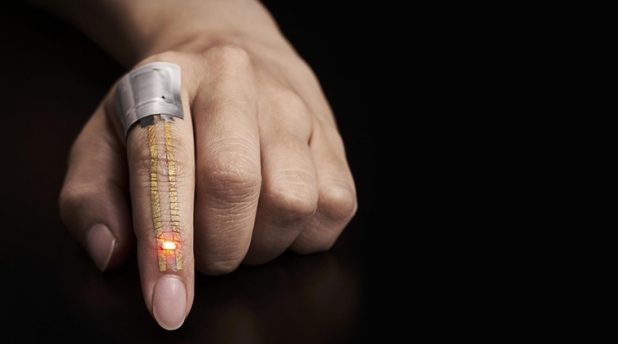
This sensor can monitor muscle activity and body temperature while being almost unnoticed.
Other wearables are able to diagnose chronic diseases in their early stages.
Сardiac monitors
Each year it becomes easier to measure heart rate: some smartwatches and fitness bands are able to provide this information. However, sometimes people need more than a simple heart rate measurement for fitness purposes. This is when cardiac monitors come in handy.
They are able to give more precise information as they are worn on the chest. Cardiac monitors aren’t as popular as other types of medical wearables, but still, they are useful in particular cases.
These are the most popular types of medical wearables.
3 best wearable medical apps
Most medical wearable makers create their own wearable medical applications, however, some of them give other mobile app makers an opportunity to make their apps compatible with these wearables. For example, any development company can create an app for Apple Watch or wristbands.
Let’s look at apps for medical wearables and explore what valuable data they provide to their users. Here are the 3 top wearable medical applications:
Hexoskin
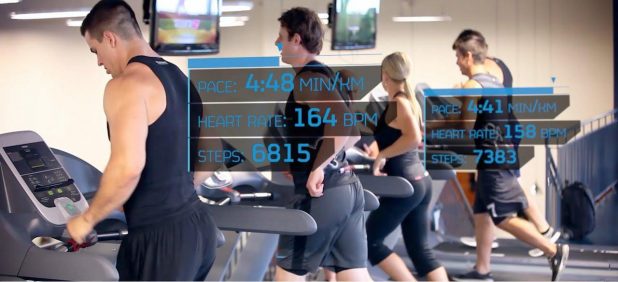
Hexoskin is one of the brightest examples of smart clothing. It records accurate heartbeat measurements and ECG without the need to attach separate sensors to your skin. Hexoskin is one of the rare wearable medical apps that track lung activity and compares resting heart rate with maximum heart rate during physical activities.
The smart clothing application allows you to control other metrics as well, including:
- Real-time breathing rate
- Number of steps
- Cadence
- Heart rate recovery
- Heart rate variability
All this information provides valuable heart insights and a reading of your overall health condition.
Apple Health
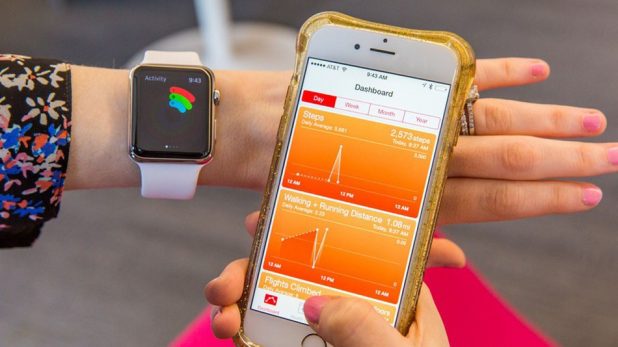
Apple Health is an official application from Apple which is compatible with Apple Watch. It works directly with HealthKit — a framework that stores and processes all health data received from mobile devices and smartwatches.
HealthKit allows third-party apps to access health data, so if you want to create a mobile app for the smartwatch, you definitely have such an opportunity to use all Apple Watch hardware. Apple Watch is becoming more advanced each year — for example, Series 4 is able to use ECG for heart rate measurements.
Apple Health app includes three parts:
- Dashboard – provides data overview
- Health data – track body measurements and physiological data
- Sources – shows how other apps work with HealthKit
Qardio
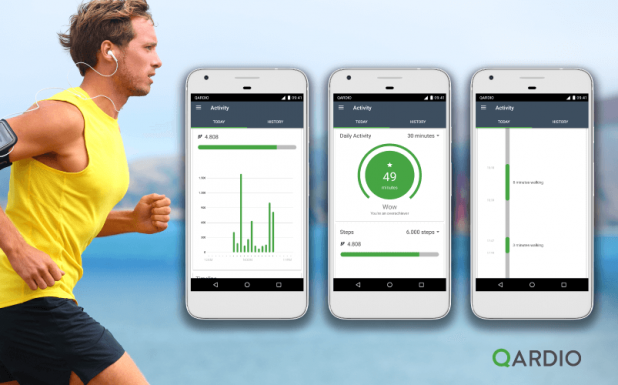
Qardio is a mobile app that gathers valuable health data from a wireless blood pressure monitor or a QardioBase smart scale that connects to a mobile phone via Bluetooth. It not only measures blood pressure but can also track your heart health and manage your weight. Qardio can be connected with Apple Watch as well, so if you are an active Apple user, you can have all your data in one place.
Final thoughts
Health is becoming a priority in most people’s lives, and I believe that it’s one of the best trends in our modern society. Technology and apps connected to wearable medical devices, in particular, help us to track our health and improve it, and it has never been easier and more fun.
Medical wearables are a promising niche, as more and more patients require, or prefer remote medical consultations and monitoring.




